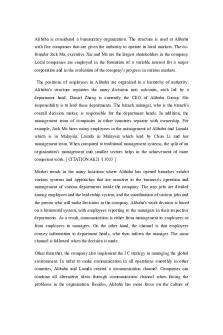RAY- Racialized Organizations PDF

| Title | RAY- Racialized Organizations |
|---|---|
| Author | Meghan Benavides |
| Course | Education and Organizational Structure |
| Institution | Seattle University |
| Pages | 3 |
| File Size | 290.6 KB |
| File Type | |
| Total Downloads | 7 |
| Total Views | 150 |
Summary
Mandatory reading on Ray and Racialized Organizations...
Description
A Theory of Racialized Organizations Victor Ray American Sociological Review, 2019 Vol. 84(1)26-53, ASA © 2019 and nd Organizations, not usually thought of together: Organizational theory •! Race a often sees organizations as race-neutral structures and race and ethnicity scholars don’t usually consider the role of organizations in the social construction of race. •! Four Tenets: o! Racialized organizations enhance or diminish the agency of racial groups o! Racialized organizations legitimate the unequal distribution of resources o! Whiteness is a credential o! The decoupling of formal rules from organizational practice is often Relates to race racialized and LMX theory Organizations izations perpetuate Ra Racism cism •! Organ from Northouse o! Emphasize human agency in racism in organization o! Plantation work began the development of scientific management and beurocratic procedures. (Page 29). BIG IDE IDEA A/G GOAL: OAL: Organizations are not race-neutral, but constituting and constituted by racial processes that shape both the policies of racial state and individual prejudice. Author combines these three scholars Jung (105) blend of Bonilla-Silva’s (1997) racialized social systems framework and Sewell’s (1992) dual theory of social structure to argue that organizations are racial structures that reproduce and challenge racialization processes. RAC RACIAL IAL AND O OR RGAN ANIZ IZ IZAT AT ATIONAL IONAL THEO THEORIE RIE RIES S ARE RE RELA LA LATED TED TED..
Levels els of Analysis in the study of Race a and nd Ethni Ethnic city Page 28: Table 1: Lev Institutio Institutional nal (Macro) Typical Analytic Representa Representative tive Conflict Over Frames Features Institutional (Macro) The racial state State racial Group membership Institutional Racism categorization State resources Racialized laws National Inclusion (explicit or implicit) Expropriation Organizational Individual Wage differences Jobs, equal pay (Mes) Workplaces Racialized Equitable education Schools Tracking Enforcement of Churches Racial Segregation anti-discrimination law Individual (Micro) Prejudice Stereotypes Interactions Racial attitudes In-Group Exclusion Implicit bias Favoritism Unequal Treatment
RACI RACIALIZA ALIZA ALIZATION: TION: the extension of ra rac cial meanin meanings gs to res resource ource ources, s, cul cultura tura turall o object bject bjects, s, emo emoti ti tions ons bodie bodies s—and fo forr our pur purpos pos poses, es, previousl iousl iously y see seen n orga organiza niza nizati ti tions ons—prev as non non--ra rac c ial
RACE RACE:: Mu Multid ltid ltidime ime imensi nsi nsional onal onal,, hiera hierarch rch rchical ical ical,, so sociop ciop ciopolitica olitica oliticall con constru stru struc ctio tion n (Ba Baker ker 19 1998 98 98;; Om Omii and Winant 2015).
•! Racialization occurs in large scale and small-scale ways •! Organizations are key to stability and change and are a part of changing perceptions on race •! Seeing organizations as racial structures—that is cultural schemas connected to social resources—can help link subfields (Page 30) Organizations are Ra Racial cial S Structures: tructures: onilla la la--Sil Silva va (199 (1997) 7) argues that racism arises as a set of historically-and •! Bonil contextually-specific ideological justifications for a societies’ racialized system (Page 31). •! Jung ((2015): 2015): Racialized social systems theory maintains a residual distinction between “structure” and culture” (Page 31). (1992) 992) 992):: Duality of Structure, emergence and continuity of social •! Sewell (1 structures and how social structures shape agency. Structures are dual in that they are simultaneous expressions of cultural schemas and the mobilization of resources. (Page 31) •! Ideological claims about racial equality (biological or cultural racism) are always expressed in relation to the distribution of resources along racial lines (Page 32). •! Organizations consolidate the “resource” or power side of dual racial structures at the meso level. o! Organizational development has been premised on cultural schemas tying non-Whites to menial labor (Page 33) formulation tion are not necessarily o! Racial structures in this authors formula institut institutionalized ionalized at the macrolevel macrolevel.. Racial structures exist when schemas a are re connected to resources in ways that di differentially fferentially adva advantage ntage racial groups at any llevel. evel. (Page 34) o! Basically, even when we try to erase racism with legal action, the smaller structures find ways of going around the new laws §! Example: Desegregation inBrown v. Board of Education, legalized school segregation coupled the racial schema of segregation with school resources to relate meso-level structures that entrenched racial inequality. Following Brown, segregation did not disappear; rather, the schema of segregation was expressed via organizational resources in new ways such as tracking programs that internally segregated students. MECHANISM ECHANISM EMERGES: When schemas and resources §! NOVEL M combine in novel ways, the racial structure is altered (Page 35).
BIG EX EXAMPLE: AMPLE: “Take for instance, police violence directed disproportionately against non-Whites in the United States (Ross 2015). When scholars claim that such violence is “structural,” they do not mean that joining a police department invariably implies one will engage in violence against nonWhites. Rather they mean the probability of violence is elevated because of the resources empowering the police (legal protections, a monopoly on violence, guns). When these resources are combined with diffuse cultural schemas-anti-Blackness, hierarchy, fear of non-Whites in general, and Black people in particular is elevated.
-Non-Whites are more likely to have jobs that are not flexible, harder to fit in family time which then further makes it difficult for families and furthers these racial structures. Moore re re’s ’s descriptive elements of White institutio institutional nal race (racialized -Page 38: Moo exclusion, racial symbolism, explicit and tac tacit it discriminat discrimination, ion, and th the e no norma rma rmativ tiv tive e elem elements ents of White institutio ions ns) - “Segregation by design, limits access to organizational resources. Racial segregation is a defining foundational characteristic of most organizations, historically enforced through custom, policy, and law (Kendi 2016; Massey and Denton 1993). -Sti Stinch nch nchcom com combe be be’s ’s claim: Most people a are re little motivated to start orga organiz niz nizatio atio ations ns if they anticipate the benefit benefits s will all be a approved pproved b by y others whom they do n not ot love. love.”” (Page 38). “THE OTHER” -Page 41: Cites Whistling Vivaldi and talks about the role of race and stereotype threat in racialization -Page 42: “Affirmative action policies recognize the credential of Whiteness and attempt to alter the nearly taken-for-granted link between Whiteness and organizational incorporation: “In many cases, organizations adopt affirmative action, diversity, and anti-discrimination policies out of fear of government sanctions but retroactively claim benevolent intent…ceremonial public relations function, but do little to change the racial distribution of organizational power.” BIG EX EXAMPLE: AMPLE: “Academic tracking stigmatizes Black students by associating Blackness with lower academic achievement.” (Page 39)
“Segregation ensures that Whites rarely shop in Black businesses and are unlikely to work for Black bosses.” Is this true in education or now? Most of my bosses have been POC
THEROY OF R RACIAL ACIAL T TASKS: ASKS: Shows how people of color, by conforming to racialized organizational scrips, can often reproduce structures of inequality....
Similar Free PDFs

RAY- Racialized Organizations
- 3 Pages

EXPONENTIAL ORGANIZATIONS
- 10 Pages

International Organizations
- 225 Pages

Ray tracing in Matlab
- 8 Pages

Foro temático Ray Berrocal
- 4 Pages

Chapter 05 Diagnosing Organizations
- 20 Pages

Business Organizations Outline
- 52 Pages

Solutions debraj ray-1
- 61 Pages

Aula V-ray - aprendendo
- 9 Pages

Bradbury Ray Fahrenheit 451
- 59 Pages

Emmet Ray - Grade: A
- 4 Pages
Popular Institutions
- Tinajero National High School - Annex
- Politeknik Caltex Riau
- Yokohama City University
- SGT University
- University of Al-Qadisiyah
- Divine Word College of Vigan
- Techniek College Rotterdam
- Universidade de Santiago
- Universiti Teknologi MARA Cawangan Johor Kampus Pasir Gudang
- Poltekkes Kemenkes Yogyakarta
- Baguio City National High School
- Colegio san marcos
- preparatoria uno
- Centro de Bachillerato Tecnológico Industrial y de Servicios No. 107
- Dalian Maritime University
- Quang Trung Secondary School
- Colegio Tecnológico en Informática
- Corporación Regional de Educación Superior
- Grupo CEDVA
- Dar Al Uloom University
- Centro de Estudios Preuniversitarios de la Universidad Nacional de Ingeniería
- 上智大学
- Aakash International School, Nuna Majara
- San Felipe Neri Catholic School
- Kang Chiao International School - New Taipei City
- Misamis Occidental National High School
- Institución Educativa Escuela Normal Juan Ladrilleros
- Kolehiyo ng Pantukan
- Batanes State College
- Instituto Continental
- Sekolah Menengah Kejuruan Kesehatan Kaltara (Tarakan)
- Colegio de La Inmaculada Concepcion - Cebu




